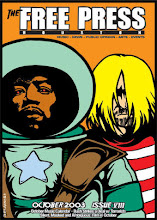(500) Days of Summer

(500) Days of Summer is what happens when indie films and studio films fuck and spawn a bastard child. The film works, I recommend the experience. It's just that every so often the (500) Days feels like its going to swerve into substandard territory at breakneck speed.
Summer (Zooey Deschanel) and Tom (Joseph Gordon-Levitt) work in the same corporate climate. He drools over her from behind his computer and professes his admiration to his work buddy McKenzie (Geoffrey Arend). Only when Tom finds himself in an elevator alone with Summer he's totally ignoring her by either pretending to be or actually so engrossed with his iTunes that he's oblivious to anything but The Smiths. She gets his attention by waving in his field of vision and mentioning that she too likes The Smiths. This is how they meet and it ain't cute.
The elevator scene mirrors the ambivalence the abounds throughout (500) Days of Summer. Tom's not the smartest card in the deck yet he's a good looking guy so it's easy to see why Summer choses him. In the elevator Tom's wearing a high end pair of earphone, as in the kind that studio engineers use, the kind I haven't seen people use since high fidelity of the 1970s. Tom's buddies McKenzie and Paul hang tight in bars drinking Bass in bottles and philosophize on their outcast state. There's always a serious side to these characters that's about to burst free but it's constantly weighed down by concessions to reality. Do we sit down with Tom and his buds and Summer and her friends and dish the goods on their life? No, but we do feature Tom in a feelgood dance number through the park where everyone starts singing and dancing with him. In case you didn't recognize the reference an animated bird lands on Tom's shoulder to remind you that this identical scene appeared in Enchanted. Where's Amy Adams when you need her?
(500) Days wants to revel in projections of movies past. Even though it's widescreen in aspect the focal length changes to a box in the center of the screen that plays out subliminal moments in black and white. If you've never seen a Truffaut or a 100 other art films this might seem original. The use of a parenthesis around the number in the title also lends credence to the fact that debut director Mark Webb wants the audience to be wowed by his use of imagery.
Getting back to the use of The Smiths in the movie (and on the soundtrack), there's more Regina Spektor in the indiginous soundtrack than Smiths. Two people meeting cute while a cool song plays in the background was done successfully this year, and that was in the movie Adventureland (The scene in question revolved around a Husker Du song.). (500) Days of Summer is not Adventureland, nor do its indie legs support the heaviosity of films like the upcoming Humpday, or even the random low budget flick du jour like In Search of a Midnight Kiss.
Yet (500) Days of Summer convinced me that the director's intentions were sincere by not being as mawkish as The Proposal or other such artificially contrived films. (500) Days walks a fine line and keeps its balance. The audience I saw the film with reacted especially loudly whenever Tom receives notification from Summer that he's now on "friend" status.








